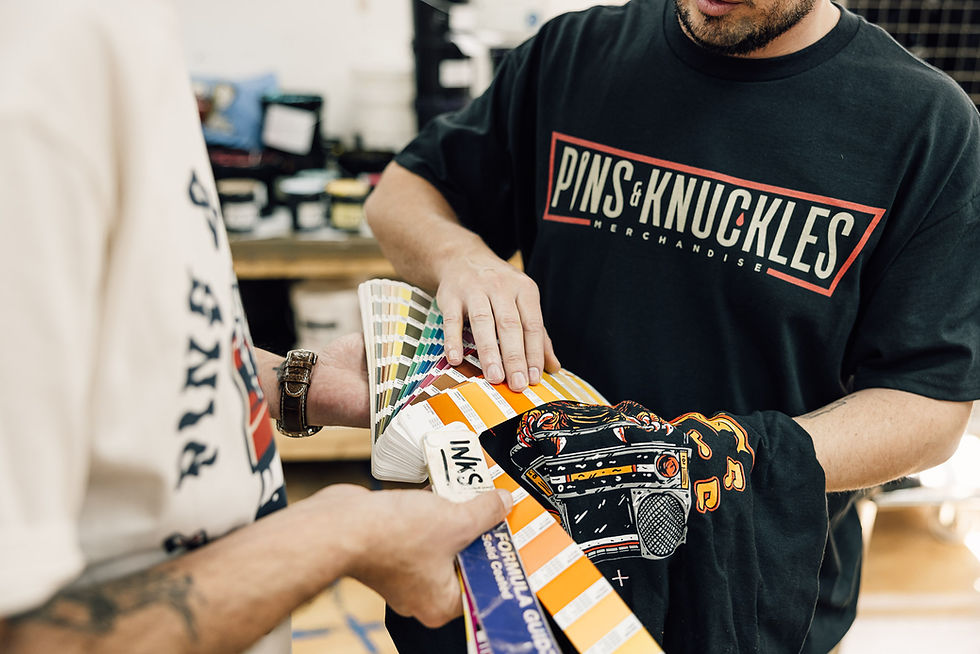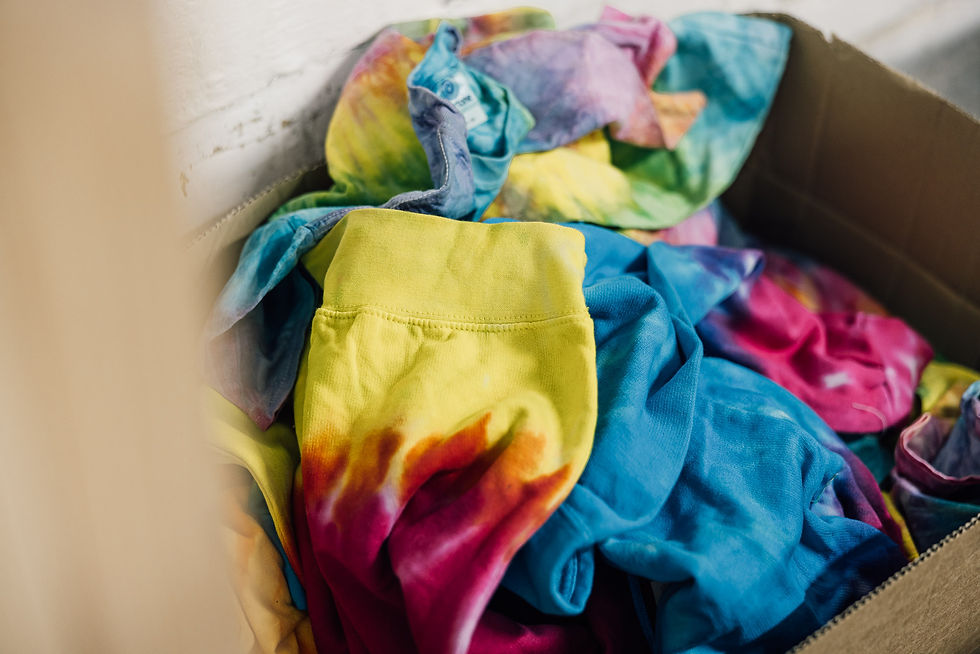HOW TO START AN ONLINE CLOTHING BRAND (FROM SCRATCH)
- pinsandknucklesmerch
- Aug 1, 2023
- 6 min read
In today's digital age, it is easier than ever to start your own online brand. We have access to a global audience at the tip of our fingers, multiple user-friendly web design sites, and smartphones that have the ability to take professional-looking product shots.
And with more and more people opting to purchase from independent businesses, there is opportunity to really build a thriving clothing brand.
Well, the idea may sound good, but where do you even start?
Maybe you've got the name and general look down, but there are a few steps to go through before actually going to market. In this blog, we go through the basic first steps to building a clothing brand, including some key resources and tips to help you succeed.

1. Define Your Brand Identity
Making sure you have a defined brand image and message is one of the most important aspects to starting your own clothing line. If you don't have a brand identity, how are people supposed to recognize you?
Consider your target audience, the style of clothing you want to offer, and the message you want to convey; then think about your brand's values, aesthetics, and unique selling proposition. This will serve as the foundation for your entire business.
This also helps in the actual garment design process. If you're outsourcing designs, then your brand guide can be sent to the graphic designer. This way, they know what colours & typography to use, what design style you're going for, and what kind of garments they should be designing for.
You can't be selling black t-shirts with heavy metal logos on the one day, and floral pink baby grows the next. Well, you probably can. But with each product, ask yourself: "How does this fit in with my brand and message? Will people recognize that I made it?"
This brand identity questionnaire by Lean Labs is a great place to start.
Some great free-to-use tools for deciding on colour palettes and font pairings include:
If you don't have a budget for a professionally-made brand identity package, at least try to have your logo made by a graphic designer. While sites like Canva are useful for some design aspects, it is not the place to be making your logo. (You can't trademark it, for starters, and you may end up finding someone else who's used the same template - oops!)
2. Conduct Market Research
Thorough market research is vital to understand the competitive landscape, consumer preferences, and trends in the fashion industry. Analyze your target market, identify gaps or opportunities, and determine how your brand can offer something unique. Pay attention to customer demands, pricing strategies, and marketing channels used by successful clothing brands.
When analyzing your competitors, ask yourself: "What are they missing?" This could be your gap to fill in the market. See what product launches do well, what products sell out, what colours are popular... There is a world of information out there!
What are people commenting on your competitors' posts? What questions are they asking? What reviews are they leaving? This way, you can see what's important to potential customers.
Have a look at Google Trends to see what's trending in your area by searching relevant terms and keywords.
While you are building up your social presence, you can also make use of tools such as the Instagram polls & question stickers. Sites like Typeform and SurveyMonkey allow you to create surveys to easily capture consumer data relevant to your brand.

3. Create a Business Plan
Developing a well-structured business plan is crucial for the success of your online clothing brand. It should include details about your brand, product offerings, target market, marketing strategies, operational logistics, and financial projections. A business plan will help you stay focused, track your progress, and secure funding if needed.
Here's a great template to help you get started.
If you really feel in the dark when it comes to getting a business plan down, consider getting a mentor. Speak to friends of friends who have their own business, go on YouTube, or follow coaches on social media.
4. Source Suppliers for Custom Merch
Nothing is going to hurt your business more than a poorly-made product. Investing in quality merch is key to your clothing brand's success. Customers will never return if their t-shirts shrink after one wash, or the print washes out.
The type of garments and branding method you choose to produce your products will depend on your designs. When reaching out to suppliers, don't be afraid to ask questions about the different options and processes, so you know exactly what to expect. Ask for recommendations if you're unsure.
At Pins & Knuckles, we're more than happy to discuss options and make suggestions based on designs, ideas and budget. By sourcing from a range of garment suppliers, we also offer clients the opportunity to get creative with their merch.
Partner with a manufacturer who offers high-end screen printing and embroidery services as well as personalized service - you want a direct point of contact if you have any concerns or questions.
5. Design & Develop Your Products
In your business plan, you may have included the number of products you want to launch with, and how you'd like to add different products in over time.
Our advice would be not to overdo it at the get-go. Start with 3-5 really strong products with unique & eye-catching designs. That way, you won't risk wasting money on a bunch of dead stock.
Whether you're designing artworks yourself or outsourcing, something to remember is that the more colours there are in your design, the more expensive it will be to print. Garment choice is also a factor, but you can always charge more for a premium product.
Important questions to ask yourself:
What season will I be launching in? Which products should I launch with?
Do I want to include customisation, such as inside neck prints or hem labels? What would that design look like?
Can I use one design across different garments to reduce production costs?
Can any of my designs be inverted to create a second version?
If you are outsourcing designs, here are some questions to ask your designer:
Do I get full license over the design once purchased?
Is it a once-off payment for the design, or do you expect royalty fees?
For those looking at doing pre-orders (where you sell the product before going to production), ask your designer to create some high-quality mock-ups of your design that you can add to your website and post to social media.
You can find free mock-up files and DIY too. Great sites for this include Unblast and Mockupworld.

6. Build Your Online Store
Thankfully, there are a number of easy-to-use platforms so that you can build your online store without any coding knowledge. Have a look at:
Don't overcomplicate it! Keep your website simple and make sure your products are front & center. Include an "About" story to share a little about the brand. If you're struggling with the copywriting bit, give ChatGPT a spin. Besides your Home, Shop & About pages, you'll also need:
Privacy policy & terms page
Delivery & returns page
Contact page
Optional: Blog page
Make sure you have lots of good quality photographs of your clothing that showcase the look and feel of the brand. Mix it up between model and product shots. And don't forget to edit the mobile layout of your site to ensure it is optimized for mobile.
Finding Design has some really useful checklists to help you make sure you don't miss a thing.
Have a look at your competitors' sites - what do you like/not like about their websites?
7. Come up with a Marketing Strategy
You have the products, you have your site - now you need to market your brand. Promoting your online clothing brand is crucial to attracting customers and generating sales. Utilize social media platforms, influencer collaborations, content marketing, and search engine optimization (SEO) techniques to increase brand visibility. Engage with your audience through compelling storytelling, behind-the-scenes content, and promotions to build a loyal customer base.
Follow social media marketing experts for insights and tips. This template by Hootsuite will help you come up with your own social media marketing strategy.
Google also offers a load of free training courses on subjects like digital marketing, SEO, Google Ads, Google Business, and more.
8. The Other Bits
There is so much that goes into running a clothing business, it's hard to fit in all of the detail! We'd definitely recommend doing further research into each step, but these points are pretty much the foundation.
Other things to consider include:
Packaging & delivery: Are you going to invest in custom packaging for your orders? How will you deliver orders and will you include freebies in any orders?
Loyalty programs: Are you going to offer discount codes to returning customers, or some type of referral incentive? How will you implement this?
New product launches: How often will you release a new product? What timeframe would be sustainable for you as a brand?
Collaborations: Can you collaborate with other brands and businesses to reach a wider audience?
Brick & Mortar: Can you stock your products on consignment in stores? Will you sell at markets? How will you implement this?
While starting your own clothing brand requires careful planning, dedication and attention to detail, it can be highly rewarding and a way for you to express your style and creativity.
Embrace your vision, leverage the power of high-quality screen printing and embroidery, connect with your target audience, and create a brand that stands out in the competitive world of online fashion.
Looking to get some merch made for your clothing brand?
Don't hesitate to email us with any questions you may have - sales@pinsandknucklesmerch.com














